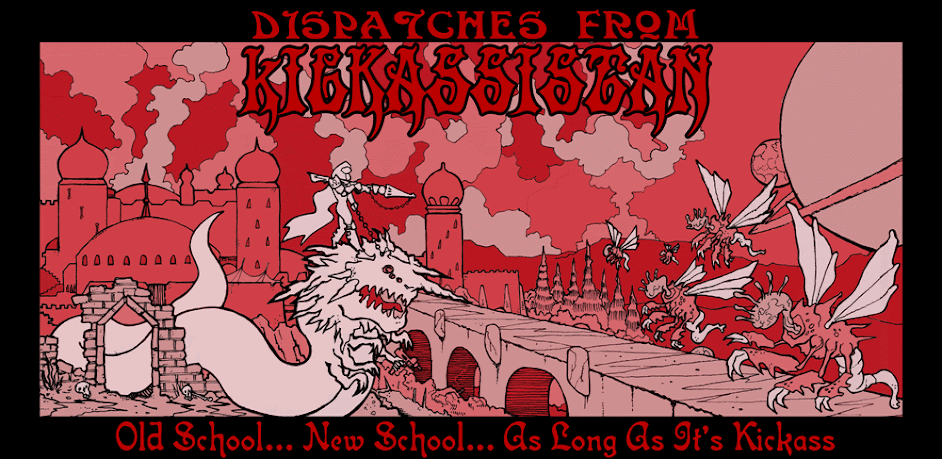No, I still haven't finished up that elf post. I have a schedule to keep, people, and I can't always get to everything. For today's #AtoZRPG, we're on to a hard letter, "H," and so you're getting a rare treat: a look inside the mind of the Metal Gods of Ur-Hadad players and an in-joke that we found hilarious. While we were killing some mushroom people in the Undercity of Ur-Hadad while Edgar, someone (I honestly can't remember who) called them "goblins," but must have yawned when he did so, because it came out as "gerblins," in a voice that sounded part-way between the Swedish Chef and Lumpy Space Princess. Since there are no such things as "goblins" or "hobgoblins" for that matter, the "herbgerblin" of Ur-Hadad was born. We laughed for far too long about the herbgerblin (you can probably get most of the Metal Gods players to lose their shit if you say "herbgerblin" to him), and decided that the herbgerblin actually needed to be a thing. So, here you go.

In a world such as Ore, it is easy to forget that no matter how fantastic the things that actually exist are, the imaginations of those who live on her bear even stranger fruit. In a world rife with vermen and Beastmen of all stripes, in a world where the Sargovax of Pluur consumes everything in its path (even cities), where godlike sorcerers call down horrific plagues and nameless maledictions, things as simple as the archetypal "monster under the bed" may get lost in the shuffle, but a clever observer should never doubt that the mind that conjures forth such a monster is capable of creating far more fantastic things than ever will actually exist on the face of Ore. For each presumably-imagined creature that Man discovers to actually be a living, breathing being, at least ten more chimerical "herbgerblins" (the catchall term for such imaginary creatures) are invented. In fact, most sages regard all creatures recounted by travelers -- until sufficient evidence of their existence is provided -- as herbgerblins.
Though the exact etymology of the term "herbgerblins" is not accurately recorded, one of the most popular explanation suggests that a traveler from some other sphere, upon witnessing the diverse peoples and monsters of Ore, was surprised that there were no "herbgerblins" to be found here. The question that followed, of course, was for an explanation of just what a "herbgerblin" was; the answer was so disappointing that the visitor was more or less laughed off the face of Ore. Ever since, the term "herbgerblin" has been applied to the products of overactive imaginations, often as a term of derision.
 Among common folk, superstition often blames the unexplained on herbgerblins until a more reasonable explanation can be found. Small thefts, goat mutilations and unexplained circles and patterns found in crops almost always get blamed on fictional herbgerblins first, until investigators prove that vermen, goat-sucking abominations or space aliens are behind the nefarious activity. Some villains and monsters exploit this blame-throwing, giving their black deeds a veneer of herbgerblin-like incredulity just to throw commoners off the scent. Often, despite the best evidence to the contrary, such common folk continue to foster a belief in these monsters of myth and folklore; nefarious hucksters and swindlers will always be on hand to take advantage of such irrational and persistent beliefs.
Among common folk, superstition often blames the unexplained on herbgerblins until a more reasonable explanation can be found. Small thefts, goat mutilations and unexplained circles and patterns found in crops almost always get blamed on fictional herbgerblins first, until investigators prove that vermen, goat-sucking abominations or space aliens are behind the nefarious activity. Some villains and monsters exploit this blame-throwing, giving their black deeds a veneer of herbgerblin-like incredulity just to throw commoners off the scent. Often, despite the best evidence to the contrary, such common folk continue to foster a belief in these monsters of myth and folklore; nefarious hucksters and swindlers will always be on hand to take advantage of such irrational and persistent beliefs.

In a world such as Ore, it is easy to forget that no matter how fantastic the things that actually exist are, the imaginations of those who live on her bear even stranger fruit. In a world rife with vermen and Beastmen of all stripes, in a world where the Sargovax of Pluur consumes everything in its path (even cities), where godlike sorcerers call down horrific plagues and nameless maledictions, things as simple as the archetypal "monster under the bed" may get lost in the shuffle, but a clever observer should never doubt that the mind that conjures forth such a monster is capable of creating far more fantastic things than ever will actually exist on the face of Ore. For each presumably-imagined creature that Man discovers to actually be a living, breathing being, at least ten more chimerical "herbgerblins" (the catchall term for such imaginary creatures) are invented. In fact, most sages regard all creatures recounted by travelers -- until sufficient evidence of their existence is provided -- as herbgerblins.
Though the exact etymology of the term "herbgerblins" is not accurately recorded, one of the most popular explanation suggests that a traveler from some other sphere, upon witnessing the diverse peoples and monsters of Ore, was surprised that there were no "herbgerblins" to be found here. The question that followed, of course, was for an explanation of just what a "herbgerblin" was; the answer was so disappointing that the visitor was more or less laughed off the face of Ore. Ever since, the term "herbgerblin" has been applied to the products of overactive imaginations, often as a term of derision.
